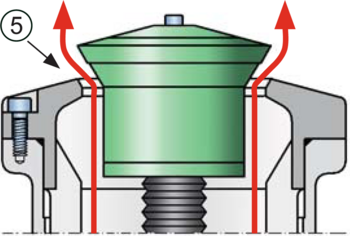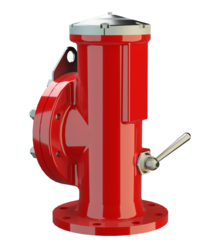DE/S-MK VI - IIC
High Velocity Pressure Relief Valve deflagration- and endurance burning-proof
- pressure is set with corrosion resistant permanent magnet
- jump characteristic within minimum overpressure to a full lift
- excellent tightness for minimum product loss and environmental pollution
- set pressure very near to the relieving pressure enables optimum pressure maintenance in the system
- can be used as a protective system according to ATEX in areas subject to an explosion hazard
- protection against atmospheric defl agrations and endurance burning
- high flow capacity
- maintenance-friendly design
- internal parts protected by bellows
- manual lift gear to pop valve cone
- side connection for a vacuum relief valve
- design promotes rain water drainage
- prevents gas build up on deck by meeting IMO requirements for minimum free jet velocity
- specially developed for sea going vessels but also useful for inland navigation vessels or on shore systems
Function and Description
The deflagration proof and endurance burning proof PROTEGO® DE/S-MKVI type device is a state of the art high velocity vent valve working on the principle of a dynamic flame arrester. It is primarily used as a device for flame transmission proof venting of cargo spaces and loading systems of tankships during the loading process and on the journey. The valve offers reliable protection against excess pressure, prevents product losses almost up to the set pressure and provides protection against atmospheric deflagrations as well as endurance burning if stabilized burning occurs. The PROTEGO® DE/S-MKVI high velocity vent valve is available for substances of explosion group IIC (NEC group B MESG < 0,50 mm).
The valve cone (1) is kept in a closed position by a corrosion resistant permanent magnet (2). The set pressure is adjusted by the distance of the permanent magnet to its counterpart (3). Upon reaching the set pressure, the valve opens directly to a full lift with only a minor pressure rise (jump characteristic). The et pressure is therefore very close to the maximum allowable working pressure (MAWP) of the cargo space.
The tank pressure is maintained up to the set pressure with a tightness that is far superior to the conventional standard due to our state of the art manufacturing technology. This feature is ensured by valve seats made of high-quality stainless steel with an individually lapped valve cone. After the excess pressure is discharged, the valve reseats and provides a tight seal. The design of the valve cone and valve seat produces a vertical, free jet that transports the gases far away from the discharge opening. This keeps the deck free of gas. The shape of the valve cone and valve seat promotes the drainage of rainwater when closed. A function check of the valve is easily performed with a manual lift gear (4) which returns to its initial position after actuation. A lateral flange connection, DN2, is standard for a vacuum valve (such as the PROTEGO® SV/E-S, see volume 7).
If the set pressure is exceeded, explosive gas/product-vapour air mixtures are released to the atmosphere. When reaching the adjusted set pressure, the velocity at which the mixtures exit the valve cone gap (5) (the gap between the valve seat and the valve cone) is much higher than the flame velocity. If this mixture ignites, flashback into the tank is prevented. If the mixture flow continues, the dynamic flame arresting feature prevents flashback ignition even in the case of endurance burning. As the system pressure decreases, the discharge velocity at the valve cone gap decreases also. The design ensures, that even in the closing pressure range, the valve cone closes in a timely manner keeping the discharge velocity far above the flame velocity and thereby preventing flashback.
The PROTEGO® DE/S-MKVI high velocity pressure relief valve is also approved for oscillating fl ow. A pipe of length no longer than the maximum tested length may be installed between the cargo space and the valve.The design is therefore a function of the required flow capacity. The design for explosion group IIC (NEC group B) is only available with a lift of 10 mm.
The valve can be used at an operating temperature up to +60°C / 140°°F; since the valve is approved for group IIC (NEC group B MESG < 0,50 mm) vapours, it also meets the requirements of European Marine Equipment Directive (MED).
Type-approved according to ATEX Directive as per EN 12874.
Dimensions
To select the nominal size (DN), please use the flow capacity chart on the following page
| DE / S with closed lateral connection DN 2 | ||||
| DN 1 | 80 / 3" | 100 / 4" | 150 / 6" | |
| a | 515 / 20.28 | 515 / 20.28 | 515 / 20.28 | |
| b | 195 / 7.68 | 195 / 7.68 | 195 / 7.68 | |
| c | 220 / 8.66 | 220 / 8.66 | 220 / 8.66 | |
| d | 120 / 4.72 | 120 / 4.72 | 120 / 4.72 | |
| e1 | 145 / 5.71 | 145 / 5.71 | 145 / 5.71 | |
| DE / S with lateral connection for vacuum relief valve DN 2 | ||||
| DN 1 | 80 / 3" | 100 / 4" | 150 / 6" | 150 / 6" |
| DN 2 | 80 / 3" | 80 / 3" | 80 / 3" | 150 / 6" |
| a | 515 / 20.28 | 515 / 20.28 | 515 / 20.28 | 515 / 20.28 |
| b | 195 / 7.68 | 195 / 7.68 | 195 / 7.68 | 195 / 7.68 |
| c | 220 / 8.66 | 220 / 8.66 | 220 / 8.66 | 220 / 8.66 |
| d | 120 / 4.72 | 120 / 4.72 | 120 / 4.72 | 120 / 4.72 |
| e2 | 100 / 3.94 | 100 / 3.94 | 100 / 3.94 | 100 / 3.94 |
Material selection
| Design | A | B | C |
| Housing | Steel | Stainless Steel | Hastelloy |
| Valve seat | Stainless Steel | Stainless Steel | Hastelloy |
| Valve cone | Stainless Steel | Stainless Steel | Hastelloy |
| Bellow | PTFE | PTFE | PTFE |
| Gasket | PTFE | PTFE | PTFE |
Selection of explosion group
| MESG | Expl. Gr. (IEC / CEN) | Gas Group (NEC) |
| < 0,50 mm | IIC | B |
Flange connection type
| EN 1092-1; Form B1 |
| ASME B16.5 CL 150 R.F. |
Design Types and Specifications
There are two different designs
Pressure relief valve, basic design with 10 mm lift | DE/S-MK VI - 10 |
Pressure relief valve with 10 mm lift and lateral connection for a vacuum relief valve | DE/S-MK VI - 10 - * |
* additional DN 2 information
Additional special designs upon request
Settings
| +60 mbar | +350 mbar | ||
| +24 inch W.C. | +140 inch W.C. |
Flow Capacity Chart

The flow capacity charts have been determined with a calibrated and TÜV certified flow capacity test rig. Volume flow V in (m³/h) and CFH refer to the standard reference conditions of air ISO 6358 (20°C, 1bar). For conversion to other densities and temperatures refer to Sec. 1: “Technical Fundamentals”.


